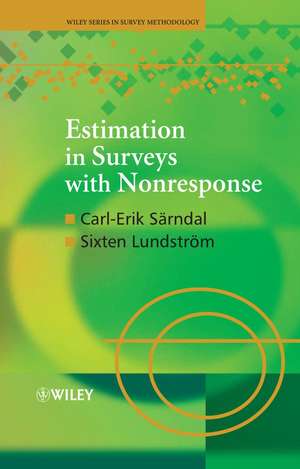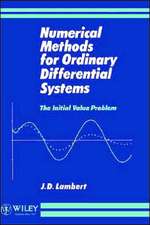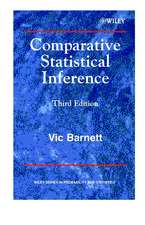Estimation in Surveys with Nonresponse: Wiley Series in Survey Methodology
Autor C–E Sarndalen Limba Engleză Hardback – 9 iun 2005
Din seria Wiley Series in Survey Methodology
- 24%
 Preț: 643.27 lei
Preț: 643.27 lei - 9%
 Preț: 1009.73 lei
Preț: 1009.73 lei - 9%
 Preț: 1058.54 lei
Preț: 1058.54 lei - 9%
 Preț: 869.51 lei
Preț: 869.51 lei - 9%
 Preț: 1052.25 lei
Preț: 1052.25 lei - 9%
 Preț: 895.15 lei
Preț: 895.15 lei - 9%
 Preț: 1164.87 lei
Preț: 1164.87 lei - 9%
 Preț: 1215.09 lei
Preț: 1215.09 lei - 5%
 Preț: 673.14 lei
Preț: 673.14 lei - 9%
 Preț: 863.27 lei
Preț: 863.27 lei - 9%
 Preț: 797.85 lei
Preț: 797.85 lei - 5%
 Preț: 1227.71 lei
Preț: 1227.71 lei - 9%
 Preț: 1083.99 lei
Preț: 1083.99 lei - 9%
 Preț: 1121.24 lei
Preț: 1121.24 lei - 9%
 Preț: 867.03 lei
Preț: 867.03 lei - 9%
 Preț: 1139.17 lei
Preț: 1139.17 lei - 9%
 Preț: 1041.73 lei
Preț: 1041.73 lei - 9%
 Preț: 923.82 lei
Preț: 923.82 lei - 9%
 Preț: 1688.43 lei
Preț: 1688.43 lei - 9%
 Preț: 877.64 lei
Preț: 877.64 lei - 9%
 Preț: 888.52 lei
Preț: 888.52 lei - 8%
 Preț: 646.44 lei
Preț: 646.44 lei - 8%
 Preț: 548.16 lei
Preț: 548.16 lei - 9%
 Preț: 732.07 lei
Preț: 732.07 lei - 5%
 Preț: 609.85 lei
Preț: 609.85 lei - 8%
 Preț: 586.37 lei
Preț: 586.37 lei - 8%
 Preț: 515.80 lei
Preț: 515.80 lei - 8%
 Preț: 599.46 lei
Preț: 599.46 lei - 8%
 Preț: 556.13 lei
Preț: 556.13 lei - 8%
 Preț: 675.49 lei
Preț: 675.49 lei - 9%
 Preț: 718.76 lei
Preț: 718.76 lei - 9%
 Preț: 703.76 lei
Preț: 703.76 lei - 9%
 Preț: 721.37 lei
Preț: 721.37 lei - 9%
 Preț: 723.58 lei
Preț: 723.58 lei - 9%
 Preț: 842.68 lei
Preț: 842.68 lei - 23%
 Preț: 594.41 lei
Preț: 594.41 lei - 32%
 Preț: 609.09 lei
Preț: 609.09 lei - 33%
 Preț: 825.03 lei
Preț: 825.03 lei - 30%
 Preț: 465.72 lei
Preț: 465.72 lei - 31%
 Preț: 456.38 lei
Preț: 456.38 lei - 28%
 Preț: 417.54 lei
Preț: 417.54 lei - 29%
 Preț: 414.89 lei
Preț: 414.89 lei - 31%
 Preț: 506.19 lei
Preț: 506.19 lei - 29%
 Preț: 447.94 lei
Preț: 447.94 lei - 29%
 Preț: 677.04 lei
Preț: 677.04 lei - 31%
 Preț: 518.91 lei
Preț: 518.91 lei
Preț: 767.98 lei
Preț vechi: 843.94 lei
-9% Nou
Puncte Express: 1152
Preț estimativ în valută:
146.95€ • 153.84$ • 121.59£
146.95€ • 153.84$ • 121.59£
Carte tipărită la comandă
Livrare economică 05-19 aprilie
Preluare comenzi: 021 569.72.76
Specificații
ISBN-13: 9780470011331
ISBN-10: 0470011335
Pagini: 212
Dimensiuni: 152 x 229 x 15 mm
Greutate: 0.44 kg
Editura: Wiley
Seria Wiley Series in Survey Methodology
Locul publicării:Chichester, United Kingdom
ISBN-10: 0470011335
Pagini: 212
Dimensiuni: 152 x 229 x 15 mm
Greutate: 0.44 kg
Editura: Wiley
Seria Wiley Series in Survey Methodology
Locul publicării:Chichester, United Kingdom
Public țintă
It will appeal to r esearchers and practitioners analyzing data from statistical surveys. Also suitable as supplementary reading for graduate students of survey statistics.Cuprins
Preface.
1. Introduction.
2. The Survey and its Imperfections .
2.1 The Survey Objective.
2.2 Sources of Error in a Survey.
3. General Principles to Assist Estimation.
3.1 Introduction.
3.2 The Importance of Auxiliary Information.
3.3 Desirable Features of Auxiliary Vector.
4. The Use of Auxiliary Information under Ideal Conditions.
4.1 Introduction.
4.2 The Horvitz-Thomson Estimator.
4.3 The Generalised Regression Estimator.
4.4 Variance and Variance Estimation.
4.5 Examples of the Generalised Regression Estimator.
5. Introduction to Estimation in the Presence of Nonresponse.
5.1 General Background.
5.2 Errors Caused by Sampling and Nonresponse.
Appendix: Variance and Mean Squared Error under Nonresponse.
6. Weighting of Data in the Presence of Nonresponse.
6.1 Traditional Approaches to Weighting.
6.2 Auxiliary Vectors and Auxiliary Information.
6.3 The Calibration Approach: Some Terminology.
6.4 Point Estimation under the Calibration Approach.
6.5 Calibration Estimators for Domains.
6.6 Comments on the Calibration Approach.
6.7 Alternative Sets of Calibrated Weights.
6.8 Properties of the Calibrated Weights.
7. Examples of Calibration Estimators.
7.1 Examples of Familiar Estimators for Data with Nonresponse.
7.2 The Simplest Auxiliary Vector.
7.3 One-way Classification.
7.4 A Single Quantitative Auxiliary Variable.
7.5 One-way Classification Combined with a Quantitative Variable.
7.6 Two-way Classification.
7.7 A Monte-Carlo Simulation Study.
8. The Combined Use of Sample Information and Population
Information.
8.1 Options for Combined Use of Information.
8.2 An Example of Calibration with Information at Both Levels.
8.3 A Monte-Carlo Simulation Study of Alternative Calibration Procedures.
8.4 Two-step Procedures in Practice.
9. Analyzing the Bias due to Nonresponse.
9.1 Simple Estimators and their Nonresponse Bias.
9.2 Finding an Efficient Grouping.
9.3 Further Illustrations of the Nonresponse Bias.
9.4 A General Expression for the Bias of the Calibration Estimator.
9.5 Conditions for Near Unbiasedness.
9.6 A Review of Concepts, Terms and Ideas.
Appendix: Proof of Proposition 9.4.1.
10. Selecting the Most Relevant Auxiliary Information.
10.1 Discussion.
10.2 Guidelines for the Construction of an Auxiliary Vector.
10.3 The Prospects for Near-zero Bias with Traditional Estimators.
10.4 Further Avenues toward a Zero Bias.
10.5 A Further Tool for Reducing the Bias.
10.6 The Search for a Powerful Auxiliary Vector.
10.7 Empirical Illustrations of the Indicators.
10.8 Literature Review.
11. Variance and Variance Estimation.
11.1 Variance Estimation for the Calibration Estimator.
11.2 An Estimator for Ideal Conditions.
11.3 A Useful Relationship.
11.4 Variance Estimation for Two-step A and Two-step B.
11.5 A Simulation Study of the Variance Estimation Technique.
11.6 Computational Aspects on Point Estimation and Variance Estimation.
Appendix: Properties of the Two-phase GREG Estimator.
12. Imputation.
12.1 What is Imputation?
12.2 Terminology.
12.3 Multiple Study Variables.
12.4 The Full Imputation Approach.
12.5 The Combined Approach.
12.6 The Full Weighting Approach.
12.7 Imputation by Statistical Rules.
12.8 Imputation by Expert Judgement or Historical Data.
13. Variance Estimation in the Presence of Imputation.
13.1 Issues in Variance Estimation under the Full Imputation Approach.
13.2 An Identity of Combined and Fully Weighted Approaches.
13.3 Further on the Risk of Underestimating the Variance.
13.4 A Broader View of Variance Estimation for the Combined Approach.
13.5 Other Issues Arising in regard to Item Nonresponse.
13.6 Further Comments on Imputation.
Appendix: Proof of Proposition 13.2.1.
14. Estimation in the Presence of Nonresponse and Frame
Imperfections.
14.1 Introduction.
14.2 Estimation of the Persistor Total.
14.3 Direct Estimation of the Target Population Total.
14.4 A Case Study.
References.
Index.
Descriere
Around the world a multitude of surveys are conducted every day, on a variety of subjects, and consequently surveys have become an accepted part of modern life. However, in recent years survey estimates have been increasingly affected by rising trends in nonresponse, with loss of accuracy as an undesirable result.




















